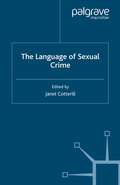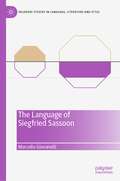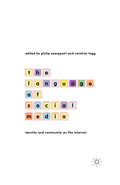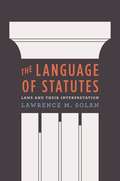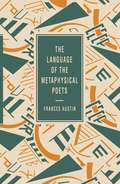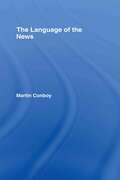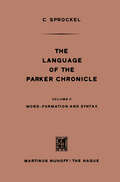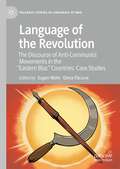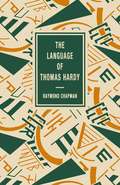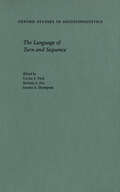- Table View
- List View
The Language of Science
by Carol ReevesThe communication of scientific principles is becoming increasingly important in a world that relies on technology. Exploring the use of scientific language in the news and examining how important scientific ideas are reported and communicated, this title in the Intertext series takes a look at the use and misuse of scientific language and how it shapes our lives. The Language of Science: explores the goals of, and problems with, scientific language and terminology demonstrates the power and misuse of scientific discourse in the media examines the special qualities of scientific communication explores how science and popular culture interact is illustrated with a wide range of examples from the MMR vaccine to AIDS and the biological weapons debate, and includes a glossary as well as ideas for further reading. This practical book is ideal for post-16 to undergraduate students in English Language, Linguistics, Journalism, Communications Studies or Science Communication.
The Language of Sexual Crime
by J. CotterillThe Language of Sexual Crime explores the role of language in the construction of identity of both perpetrators and victims of sexual violence, the ways in which language is used in the detection of sexually-motivated crime, and the articulation/manipulation of language in police interviews, the courtroom and the media.
The Language of Shakespeare (The Language of Literature)
by Norman BlakeThis book provides an accessible guide to the linguistic environment of Shakespeare, his use of vocabulary, grammar and sentence construction. Although Shakespeare's plays are familiar to us, the language in them is not always easy to understand or translate. Not only does Shakespeare use difficult and seemingly archaic words, but also constructs his sentences and makes use of grammar in a very different way to modern writers. This book is an introduction to the various aspects of the language of Shakespeare and his contemporaries. Professor Blake has provided an accessible guide to the linguistic environment of Shakespeare, his use of vocabulary, grammar and sentence construction. By understanding Shakespeare's language students can avoid misinterpretation, recognise the possibilities of linguistic meaning and so fully appreciate Shakespeare's formidable artistry.
The Language of Siegfried Sassoon (Palgrave Studies in Language, Literature and Style)
by Marcello GiovanelliThis book presents a cognitive stylistic analysis of the writing of Siegfried Sassoon, a First World War poet who has typically been perceived as a poet of protest and irony, but whose work is in fact multi-faceted and complex in theme and shifted in style considerably throughout his lifetime. The author starts from the premise that a more systematic account of Sassoon’s style is possible using the methodology of contemporary stylistics, in particular Cognitive Grammar. Using this as a starting point, he revisits common ideas from Sassoon scholarship and reconfigures them through the lens of cognitive stylistics to provide a fresh perspective on Sassoon's style. This book will be of interest to students and scholars of stylistics, war poetry, twentieth-century literature, and cognitive linguistics.
The Language of Silence: West German Literature and the Holocaust
by Ernestine SchlantFocusing on individual authors from Heinrich Boll to Gunther Grass, Hermann Lenz to Peter Schneider, The Language of Silence offers an analysis of West German literature as it tries to come to terms with the Holocaust and its impact on postwar West German society. Exploring postwar literature as the barometer of Germany's unconsciously held values as well as of its professed conscience, Ernestine Schlant demonstrates that the confrontation with the Holocaust has shifted over the decades from repression, circumvention, and omission to an open acknowledgement of the crimes. Yet even today a 'language of silence' remains since the victims and their suffering are still overlooked and ignored. Learned and exacting, Schlant's study makes an important contribution to our understanding of postwar German culture.
The Language of Silence: West German Literature and the Holocaust
by Ernestine SchlantFocusing on individual authors from Heinrich Boll to Gunther Grass, Hermann Lenz to Peter Schneider, The Language of Silence offers an analysis of West German literature as it tries to come to terms with the Holocaust and its impact on postwar West German society. Exploring postwar literature as the barometer of Germany's unconsciously held values as well as of its professed conscience, Ernestine Schlant demonstrates that the confrontation with the Holocaust has shifted over the decades from repression, circumvention, and omission to an open acknowledgement of the crimes. Yet even today a 'language of silence' remains since the victims and their suffering are still overlooked and ignored. Learned and exacting, Schlant's study makes an important contribution to our understanding of postwar German culture.
The Language of Social Media: Identity and Community on the Internet
by Philip Seargeant Caroline TaggThis timely book examines language on social media sites including Facebook and Twitter. Studies from leading language researchers, and experts on social media, explore how social media is having an impact on how we relate to each other, the communities we live in, and the way we present a sense of self in twenty-first century society.
The Language of Statutes: Laws and Their Interpretation (Chicago Series in Law and Society)
by Lawrence M. SolanPulling the rug out from debates about interpretation, The Language of Statutes joins together learning from law, linguistics, and cognitive science to illuminate the fundamental issues and problems in this highly contested area. Here, Lawrence M. Solan argues that statutory interpretation is alive, well, and not in need of the major overhaul that many have suggested. Rather, he suggests, the majority of people understand their rights and obligations most of the time, with difficult cases occurring in circumstances that we can predict from understanding when our minds do not work in a lawlike way. Solan explains that these cases arise because of the gap between our inability to write crisp yet flexible laws on one hand and the ways in which our cognitive and linguistic faculties are structured on the other. Making our lives easier and more efficient, we’re predisposed to absorb new situations into categories we have previously formed—but in the legislative and judicial realms this can present major difficulties. Solan provides an excellent introduction to statutory interpretation, rejecting the extreme arguments that judges have either too much or too little leeway, and explaining how and why a certain number of interpretive problems are simply inevitable.
The Language of Statutes: Laws and Their Interpretation (Chicago Series in Law and Society)
by Lawrence M. SolanPulling the rug out from debates about interpretation, The Language of Statutes joins together learning from law, linguistics, and cognitive science to illuminate the fundamental issues and problems in this highly contested area. Here, Lawrence M. Solan argues that statutory interpretation is alive, well, and not in need of the major overhaul that many have suggested. Rather, he suggests, the majority of people understand their rights and obligations most of the time, with difficult cases occurring in circumstances that we can predict from understanding when our minds do not work in a lawlike way. Solan explains that these cases arise because of the gap between our inability to write crisp yet flexible laws on one hand and the ways in which our cognitive and linguistic faculties are structured on the other. Making our lives easier and more efficient, we’re predisposed to absorb new situations into categories we have previously formed—but in the legislative and judicial realms this can present major difficulties. Solan provides an excellent introduction to statutory interpretation, rejecting the extreme arguments that judges have either too much or too little leeway, and explaining how and why a certain number of interpretive problems are simply inevitable.
The Language of Surrealism (Language, Style and Literature)
by Peter StockwellThe Language of Surrealism explores the revolutionary experiments in language and mind undertaken by the surrealists across Europe between the wars. Highly influential on the development of art, literary modernism, and current popular culture, surrealist style remains challenging, striking, resonant and thrilling – and the techniques by which surrealist writing achieves this are set out clearly in this book. Stockwell draws on recent work in cognitive poetics and literary linguistics to re-evaluate surrealism in its own historical setting. In the process, the book questions later critical theoretical views of language that have distorted our ideas about both surrealism and language itself. What follows is a piece of literary criticism that is fully contextualised, historically sensitive, and textually driven, and which sets out in rich and readable detail this most intriguing and disturbing literature.
The Language of Suspense in Crime Fiction: A Linguistic Stylistic Approach
by Reshmi Dutta-FlandersThis book introduces readers to linguistic stylistic analysis and combines both literary and linguistic analysis to explore suspense in crime fiction. Employing critical linguistics, discourse analysis and functional grammar, it demonstrates that suspense in plot-based stories is created through non-linear, causative presentation of the narrative. The author investigates how plot sequence is manipulated to ensure the reader cannot resolve the order of events until the end of the tale. From two-dimensional circumstantial detection in mystery stories to three-dimensional re-evaluation of offender orientation, she uses a linguistic-based stylistic framework to analyse offender motive. She also employs a 'discourse-based' frame analysis to examine the plot structure of crime stories for micro context and set-up scenarios, demonstrating that it is the unravelling of these devices that creates the suspense in murder mysteries and thrillers alike. Finally, she shows how grammaticization of the offending-self reveals an embedded diegetic space in the offender engagement discourse, provoking an intellectual and affective response and reshaping our overall outlook of the crime in the story. This book will appeal to researchers and students from literary and non-literary backgrounds looking for theoretical and practical advice on the linguistic stylistic approach to reading texts.
The Language of the Metaphysical Poets
by Frances AustinIn this volume, Dr Frances Austin examines the language of the five best-known metaphysical poets, Donne, Herbert, Crashaw, Vaughan and Traherne. She shows how the characteristics of their vocabulary, figurative language, syntactical structures and versification reflect their individual attitudes to their shared Christian faith, which is the subject matter of most of their poetry. The diversity of language, albeit having a common basis, is demonstrated in the course of this study.
The Language Of The News
by Martin ConboyThe Language of the News investigates and critiques the conventions of language used in newspapers and provides students with a clear introduction to critical linguistics as a tool for analysis. Using contemporary examples from UK, USA and Australian newspapers, this book deals with key themes of representation – from gender and national identity to ‘race’– and looks at how language is used to construct audiences, to persuade, and even to parody. It examines debates in the newspapers themselves about the nature of language including commentary on political correctness, the sensitive use of language and irony as a journalistic weapon. Featuring chapter openings and summaries, activities, and a wealth of examples from contemporary news coverage (including examples from television and radio), The Language of the News broadens the perceptions of the use of language in the news media and is essential reading for students of media and communication, journalism, and English language and linguistics.
The Language of the Parker Chronicle: Volume II Word-Formation and Syntax
by C. SprockelThe reception accorded to the first volume of this book has en couraged me to redeem my promise to write a sequel on the word formation and syntax of the same text. (It is hoped that my edition of the text which forms the basis of these studies will appear in due course. ) Since these aspects of Old English have been virtually ig nored by scholars so far. I do not think I need offer any apology for making some contribution to such scanty information about them as is currently at our disposal. Some friends who urged me to undertake this task added the warning that I would find myself treading on much more dangerous ground. Having gone through the experience. I must now admit that syntactic analysis presents much more intractable problems than phonology. Some information about the method followed in this treatise is to be found in the introductions to the two parts. As far as possi ble I have used conventional terms. but not without explaining in what sense they are to be understood in this work. I admit that there is plenty of room for disagreement with my conclusions; but they are conclusions which I arrived at after giving much thought to the problems in each individual case. Even in cases where the reader finds he must agree to differ. I hope he will find the argu ments stimulating.
The Language of the Parker Chronicle: Volume I: Phonology and Accidence. Academisch Proefschrift
by Cornelis SprockelThat the history of England between the death of Bede and the Norman Conquest could hardly have been written at aU but for the annalistic compilations comprehensively labelled the Anglo-Saxon Chronicle has more than once been pointed out, and the information contained in them has been made accessible to historians in a number of editions and translations by scholars from Benjamin Thorpe in 1861 to Dorothy Whitelock in our own time. That the Chronicle also affords invaluable evidence for the development of the English language, since it was almost entirely written in the vernacular, has less often been emphasized. Now, there cannot be any doubt that from this point of view the most important of its versions is the Parker Chronicle, since it is the oldest, and was written down over a period of close on two centuries. It is, therefore, surprising that this primary source of documentary evidence for the development of Old English has received so little attention since Cosijn published his Altwestsiichsische Grammatik more than three quarters of a century ago. In view of this neglect, I think I may assume that a work dealing solely with the linguistic aspect of this important document will meet a need.
The Language of the Past
by Ross WilsonThe Language of the Past analyzes the use of history in discourses within the political, media and the public sphere. It examines how particular terms, phrases and allusions first came into usage, developed and how they are employed today. To speak of something or someone as representing the 'stone age', or characterize an institution as 'byzantine', to describe a business relationship as 'feudal' or to disparage ideals or morality as 'Victorian', refers to both a perception of the past and its relationship to the present. Whilst dictionaries and etymologies define meanings and origin points of words or phrases, this study examines how history is maintained and used within society through language. Detailing the specific words and phrases associated with particular periods used to describe contemporary society, this thorough examination of language and history will be of great interest to those studying historiography, social history and linguistics.
The Language of the Past
by Ross WilsonThe Language of the Past analyzes the use of history in discourses within the political, media and the public sphere. It examines how particular terms, phrases and allusions first came into usage, developed and how they are employed today. To speak of something or someone as representing the 'stone age', or characterize an institution as 'byzantine', to describe a business relationship as 'feudal' or to disparage ideals or morality as 'Victorian', refers to both a perception of the past and its relationship to the present. Whilst dictionaries and etymologies define meanings and origin points of words or phrases, this study examines how history is maintained and used within society through language. Detailing the specific words and phrases associated with particular periods used to describe contemporary society, this thorough examination of language and history will be of great interest to those studying historiography, social history and linguistics.
Language of the Revolution: The Discourse of Anti-Communist Movements in the “Eastern Bloc” Countries: Case Studies (Palgrave Studies in Languages at War)
by Eugen Wohl Elena PăcurarThis edited book fills a void in the existing research concerning anti-communist movements in Central and Eastern Europe, outlining the linguistic implications of the cultural, social and political metamorphoses brought about by the (change of) regime. The authors included in this volume approach the topic from a variety of perspectives, but, ultimately, focus on language seen as a fundamental tool for simultaneously subjugating and liberating, concealing and revealing truth, discouraging dissidence and fostering revolt. Readers are invited to discover the linguistic implications of the many shapes and forms that the 1989 anti-communist revolutions took. Equally interesting are the investigations of the revolution aftermath, in the first years of transition to democracy. Perceived as a whole throughout the Cold War (1947-1991), the so-called "Eastern Bloc" managed to reveal its heterogeneity, the singularity of each of its comprising states and the multitude of its internal contrasts, most vividly perhaps, in the manifold manifestations of the 1989 anti-communist fight. This book will be of interest to academics and researchers from various fields, including history, (socio)linguistics, political studies, and conflict studies.
Language of Thomas Hardy
by Raymond ChapmanThis study of Hardy's literary language in both fiction and poetry, attempts to show how it reflects aspects of his life and his personal beliefs. The literary effect of his distinctive phraseology and sentence-structure is exemplified and assessed.
The Language of Thought in Late Medieval Philosophy: Essays in Honor of Claude Panaccio (Historical-Analytical Studies on Nature, Mind and Action #5)
by Jenny Pelletier Magali RoquesThis edited volume presents new lines of research dealing with the language of thought and its philosophical implications in the time of Ockham. It features more than 20 essays that also serve as a tribute to the ground-breaking work of a leading expert in late medieval philosophy: Claude Panaccio.Coverage addresses topics in the philosophy of mind and cognition (externalism, mental causation, resemblance, habits, sensory awareness, the psychology, illusion, representationalism), concepts (universal, transcendental, identity, syncategorematic), logic and language (definitions, syllogisms, modality, supposition, obligationes, etc.), action theory (belief, will, action), and more.A distinctive feature of this work is that it brings together contributions in both French and English, the two major research languages today on the main theme in question. It unites the most renowned specialists in the field as well as many of Claude Panaccio’s former students who have engaged with his work over the years. In furthering this dialogue, the essays render key topics in fourteenth-century thought accessible to the contemporary philosophical community without being anachronistic or insensitive to the particularities of the medieval context. As a result, this book will appeal to a general population of philosophers and historians of philosophy with an interest in logic, philosophy of language, philosophy of mind, and metaphysics.
The Language of Touch: Philosophical Examinations in Linguistics and Haptic Studies
by Mirt KomelOffering an in-depth analysis of the relationship between touch and language through the history of philosophy, this book revitalizes the field of haptic studies, providing new insights into the philosophy of language and ontological nature of touch. The Language of Touch draws together an international team of linguists, anthropologists, and philosophers to demonstrate from a variety of disciplinary perspectives that the experience of touch is inextricable from the structure of language. Examining the intersections between phenomenology of touch and poststructural linguistics, this work draws upon figures such as Marx, Merleau-Ponty, Nancy, Derrida, and Lacan to question both how language structures touch and how touch structures language.
The Language of Touch: Philosophical Examinations in Linguistics and Haptic Studies
by Mirt KomelOffering an in-depth analysis of the relationship between touch and language through the history of philosophy, this book revitalizes the field of haptic studies, providing new insights into the philosophy of language and ontological nature of touch. The Language of Touch draws together an international team of linguists, anthropologists, and philosophers to demonstrate from a variety of disciplinary perspectives that the experience of touch is inextricable from the structure of language. Examining the intersections between phenomenology of touch and poststructural linguistics, this work draws upon figures such as Marx, Merleau-Ponty, Nancy, Derrida, and Lacan to question both how language structures touch and how touch structures language.
The Language of Turn and Sequence (Oxford Studies in Sociolinguistics)
by Cecilia E. Ford Barbara A. Fox Sandra A. ThompsonThis collection of previously unpublished, cutting-edge research discusses the conversation analysis (CA) approach to understanding language use. CA is the dominant theory for analyzing the social use of language and is concerned with the description of how speakers engage in conversation and other forms of social interaction involving language. Its proponents are not only linguists but sociologists and anthropologists as well. The unifying theme of these chapters is the intersection of practice and form through the construction of turns and sequences.

